The smart TV market share has witnessed a significant jump in 2020. The TV technology landscape has seen a significant change and improvement, with a plethora of technologies coming up from OLEDs to QLEDs, webOS to Android OS, HD to Ultra HD, thus making a decision to buy a TV quite an interesting as well as a complex one. With the advent of Internet TV, users now watch what they want, when they want and how they want. The Indian smart TV and OTT market has become an attractive area for providers due to the growing consumer interest to switch to smart TVs from traditional TVs and the huge size of the market. Companies are investing in future-ready technologies to gain a competitive advantage.
We at Mobility magazine have spoken to some leading Smart TV brands to understand their strategies, USPs and outlook and covered them in the following passages.
The present trends and future outlook for the Smart TV segment!
According to the Smart TV providers, people are rapidly shifting to Smart TVs from traditional TVs. The trends that are overtaking the Smart TV segment are the increasing OTT viewership, more AI-driven features and technologies that allow to connect multiple devices to smart TVs, etc.


According to Mr Avneet Singh Marwah, Director and CEO, Super Plastronics Pvt Ltd (a Kodak brand licensee), the biggest trend this year has been a huge spike in OTT viewership. Smart TVs, which has maximum content with a verified UI, will attract a high demand. He says, “The next big trend for smart TVs is AI. The important requirement is no longer just the size of the TV screen, but a screen which will connect to various other smart home devices with a command of voice. For example, smart lights for various modes like (movies, sports, News), mood setting, safety & security alarms, lighting solutions, temperature control, wash settings, contactless AI driven technology solutions, etc are the new things the young and enthusiastic consumers will experiment and adopt in the year to come.”
Mr Amitabh Khurana, Director, GM-Manufacturing, Intex Smart TV, “Now with only small price differences between the non-Smart vs Smart TVs, the overall share of the Smart TVs has already reached 60%. We can foresee Smart TVs reaching over 80% of the overall LED TV numbers in next 12 months or so. Also, with the users using OTT platform as never before, every household in India, intending to buy LED TV, will prefer Smart TV.”
Mr Justin ZHONG, Retail Marketing Manager, TCL India, “At present, two types of major Smart TVs are in India. One is self-developed UI & system and the other type is Android-based TVs. And a lot of the Android-based smart TV brands are marketing their self-developed UI and content integrations, so customers can easily find a lot of Smart TV options. Due to the pandemic and lockdown, people are working from home and a lot has changed, not only in the mindsets of users, but also the way people use and watch Smart TVs. In near future, we will see people not just watching content on TV, but also multiple people video chatting, attending work meetings via bigger TV screens and TVs acting as hubs for the entire smart home.”
Mr Mandeep Arora, Co-Founder, UBON, “With the advent of high-speed Internet at affordable prices, viewers/audiences now prefer Smart TVs over other TV systems. There has been a huge increase in the content consumption through OTT platforms like Netflix and Amazon Prime impacting the smart TV market in India. Also, rise in disposable income levels and growing Internet penetration in the country are leading to an increase in sales of Smart TVs and hence fuelling the market growth. Households in India are at a cusp of transition, and a shift in preference has been witnessed from conventional TV sets to smart TV sets. Changing lifestyle patterns, adoption of new technology, and increasing Internet penetration are the key factors driving the surge in the demand of smart TV in our country.”
Mr Pawan Kumar, CEO, Elista (Teknodome India Pvt Ltd), “Smart TVs are growing by a humongous 15-18% year on year. India is still an underpenetrated market with 200 million potential households which makes it a very attractive market for the Smart TVs. Growth is driven mainly by budget Smart TVs with 32-inch.”
The impact of COVID-19 pandemic on the Smart TV market
The COVID-19 pandemic created a boom in demand for Android TVs. With more and more people turning to their TVs to enjoy movies, games, and videos, there is a huge shift in consuming content from smartphones to Smart TVs.
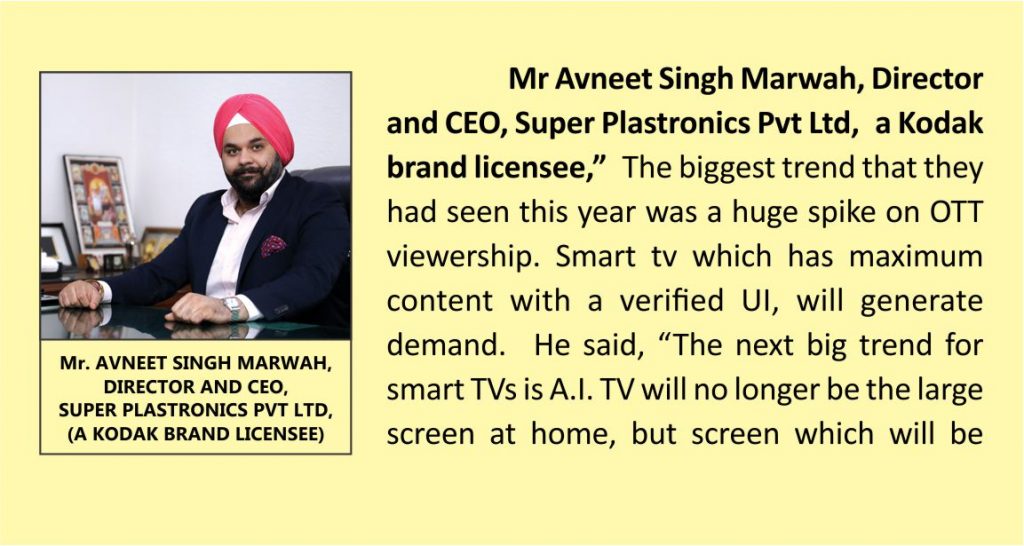
Mr Amitabh Khurana, Intex Smart TV, “Intex is always known for bringing the technologically advanced products at affordable pricing to the people of India. We have recently introduced Smart TVs with certified entertainment apps like Disney Hotstar, Zee5, Hungama Play etc on Android V9.0 (AOSP) Solution. AI-based Voice Assistant with Air Mouse, BT Audio Out, HDR display are among our hottest USPs. Then there are in-built apps with very latest Frameless Designs and above all 3-year warranty for our consumers so that they have complete peace of mind. This is a great package for the consumers that too at pocket-friendly prices.”
Mr Pawan Kumar, CEO, Elista (teknodome India Pvt Ltd ), “With COVID-19 pushing the growth of OTT subscriptions by an unprecedented 60%, the Smart TVs have seen demand from consumers like never before. Also, with the growth of the smartphone usage during the last few years, the consumer likes to continue the consumption of content seamlessly on larger screen when at home. As people were bound inside their homes during the lockdown, TV & online streaming was their only source of entertainment and it gave the big push to the demand of Smart TVs.”
Mr Mandeep Arora, MD, UBON, “There has been a huge transition in the customer behaviour due to the COVID-19 pandemic. During the lockdown, there was a huge pent-up demand for Smart TVs. So, when the government allowed sale of non-essential items, there was a boom in demand for Android TVs. During the lockdown, users had no source of entertainment other than turning to their TV sets to enjoy content, games, music, podcasts and videos. As a result, there was a huge shift from consuming content on smartphones to Smart TVs. With Smart TVs driving smart living in the post covid-19 ‘new normal,’ lifestyles have changed and so the expectations from technology.”
Justin ZHONG of TCL India, “In the past one year, especially during the lockdown period, our sales were negatively impacted, but we quickly bounced back. If we look at our 2020’s offline Smart TV penetration rate, it was 76.2%, that is 21% higher than the general market penetration rate.”
USPs and go-to-market strategies of Smart TV brands
Different brands are projecting different USPs to win the customers. Some of the common USPs brands are promoting include the latest technology, affordable prices, smart functionalities, bigger screens, local language options, easy-to-use AI-driven features and so on.
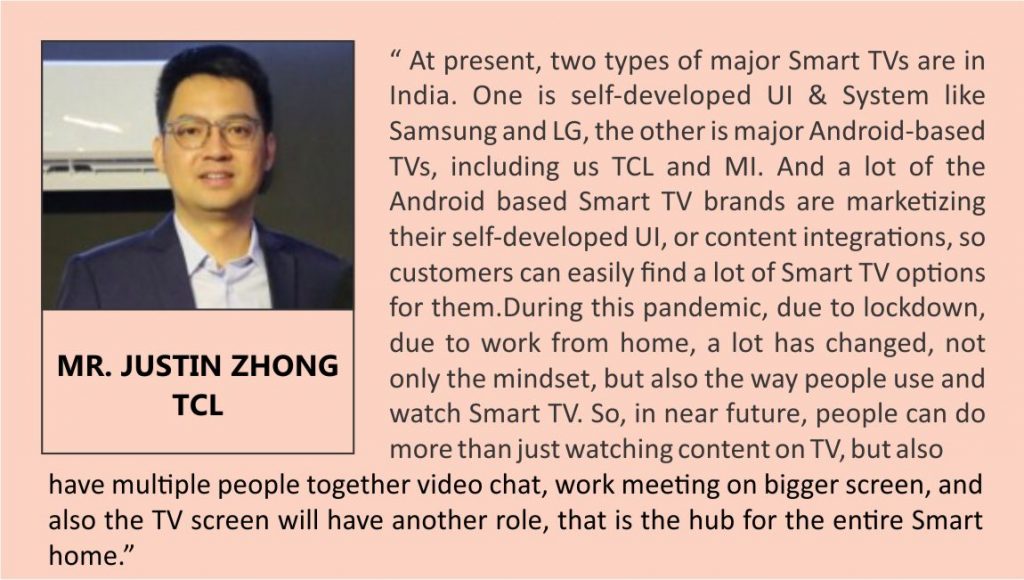
Mr Justin ZHONG of TCL India, “For different customers, we have products at different price segments. We are the first brand to introduce QLED Android TV, QLED TV with harmankardon speaker and QLED Android TV with built-in subwoofer in India. From the mid-range UHD segment, we also introduced India’s first 4K UHD TV with hands-free AI.”
Mr Pawan Kumar of Elista, “Our Smart TV range consists of UHD / FHD / HD TVs and we operate in affordable category. Our TV range is conceived and produced in India and the quality is at par with global standards.”
Mr Amitabh Khurana of Intex Smart TV, “Today, the Smart TV industry is banking more on OLED & QLED, 4K Display with HDR-10 technology etc to give better picture quality to the consumers. AI-based voice search is something that is getting better by the day and is the best innovation in the recent times.”
Mr Avneet Singh Marwah of Super Plastronics Pvt Ltd, “The USP of our brand is we work on Android OS platform, which offers the maximum number of applications and games for Smart TVs. There are more than 6000 games and apps available on our Kodak Android TV; Kodak is one of the world’s best known and most recalled brands, which gives us special edge over other brands. We have a large target audience where we have segmented our product-line according to the audience level. Starting from 24-in at Rs 7999 to 75-in premium Android TV at Rs 99,999.”
The future innovations expected in the Smart TV space!
More voice- and AI-enabled features, better picture quality and superior sound experience are the expected future innovations in the smart TV space.
Mr Pawan Kumar of Elista, “Voice- & AI-enabled smart TVs will grow in usage due to the sheer convenience they offer. As we see voice search growing by leaps and bounds on search engines, the same will reflect in the Smart TV segment too. QLED is another technology which will get more affordable and will be widely used, giving a better viewing experience to the audience. The industry is also working on more dynamic sound experience and some breakthrough is expected soon in this arena.”
Mr Amitabh Khurana of Intex Smart TV, “Industry is banking big on OLED & QLED, 4K Display with HDR-10 technology etc to give better picture quality to the consumers. AI-based voice search is something that is getting better by the day and is the best innovation in the recent times.”
Mr Avneet Singh Marwah of Super Plastronics Pvt Ltd, “As I already mentioned, the next big disruptive trend in smart TV segment will be AI-enabled features. We are aggressively working on the concept of ‘smart homes’ and how a large screen can be connected to all your devices. We are also using technology to offer functionalities in 14 local languages which will help customers view their favourite content in their preferred language.”
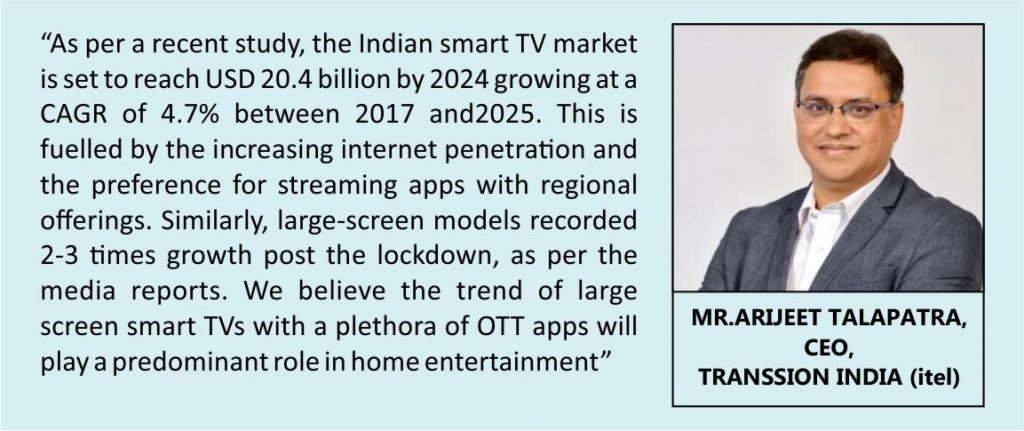
Justin ZHONG of TCL India, “Hands-free Voice Control, Video Call Camera and Gaming TV with a lot of gaming specs like VRR, HDMI 2.1, MEMC, etc will be our future innovations. TCL’s innovations will be developed to make people’s lives more intelligent and to shorten the communication gap between their loved ones. The future TVs will become ‘intelligent displays’–you watch it, have meeting on it, get social through it, play games on it and many more things on bigger screens which we now do on smaller mobile screens.”
Mr. Mandeep Arora, MD of UBON, “Resolution has been the main playground for improvement over the years and we have moved now from HD to 4K. It might sound a little like an overstatement, but prominent TV innovations would not have been possible if it weren’t for high definition technology. The first in this series comes the HD or High Definition generally offered in the budget TVs which provide the resolution of 1280×720, also called 720p where p means progressive scan. Above it comes Full HD, usually seen in mid-range TVs which provides the resolution of 1920×1080 also called 1080p and this uses the aspect ratio of 16:9. And again above it comes, as many might have already guessed is, the 4K or UHD. But then there is a difference between 4K and UHD too though they are often used interchangeably. UHD or Ultra High Definition which has the resolution of 3840×2160 is precisely twice that of Full HD and thrice that of simply HD. On the other hand, the true 4K has the resolution of 4096×2160. So, rather than being simply 4x of Full HD, 4K derives its name from measuring 4000+ pixels on its longest side. Though in a bid to better market their products, brands like Netflix and Google refer to UHD as 4K. Usually 4K is available from TVs of 40-inch and above, but to truly get the visual impact of 4K, the TV has to be big enough, ideally a TV of size 49-inch or bigger is best suited for 4K. Also the content available on 4K in India is currently limited to a few sports channels and National Geographic. So unless you watch a lot of Ultra HD movies, you will not get a lot of 4K content in India.”
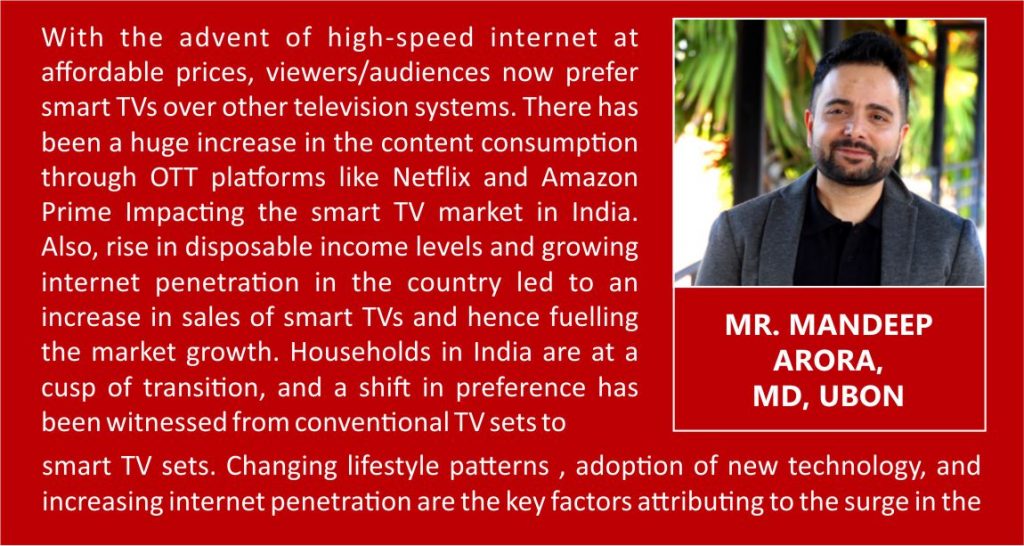
Channel strategies of different brands
The supply channel plays a very crucial role in the success of a brand. The right channel partners, the appropriate incentive plans, effective brand promotion and the education & motivation the brands give to their partners are often defining factors in a brand’s growth.
Mr Mandeep Arora of UBON, “With market competition intensifying and business becoming more challenging, classic partner programs are seen to be evolving. In today’s changing business landscape, having a trusted partner network has become more important than ever. We at UBON, review the programs and partner engagement teams (from Sales & Marketing departments) keep on motivating & inspiring partners to achieve the set goals of the programs. We are regularly offering training and certifications to our partners, also give them appreciation tokens and planning to further increase this process in the coming days. As a company, we will ensure that our partners always get their due for the efforts they put in. We have many programs where incentives are given in kind and cash incentives are generally passed on as discounts. We also have specific programs designed for the benefit of partners like for instance regular partners meet-and-greet ceremonies to recognize their efforts. As a company, we ensure that we keep things as simple and straightforward as we can for our partners. We have a large sales team equipped to handle queries and to ensure the programs are fully understood by the partners. A few factors that we are focusing on in this quarter are good rebates and incentives, account management, front end discounts, regular training, service support, ease of new partner onboarding processes, providing the right sales and marketing materials, progress reports and many others. Our channel partners have always been our backbone and they make a major contribution to the success of UBON. Distributors bridge the gap between end-users and the manufacturers and a manufacturer should treat his distributors as an integral part of their business to have a better relationship. We have been organising distributor meets time-to-time to meet and greet our partners while maintaining a healthy and transparent relationship with clear policies and rules that would help us grow with them together. We believe in growing with our partners and work with them to develop, maintain and manage productive go-to-market relationships that ultimately help sustain a competitive advantage and create a win-win situation for both. Effective marketing support, training, incentives, problem-solving assessments and recognition programs, are some of our initiatives to instil trust and empower our partners and letting them know we value their role in the success of UBON. Thus, we optimize our channel through trust-based relationships.”
Mr Pawan Kumar of Elista, “Entertainment being the pulse of South India, we launched our brand in 2020 from South and overwhelmed by the success and the response of the channel and the consumers. We are excited to be replicating this story in other parts of India in the coming months. We are soon coming up with full-fledged brand campaign which will generate consumer demand and in turn will motivate the channel. From time to time, we keep launching schemes for our channel partners which work well for us and the channel alike.”
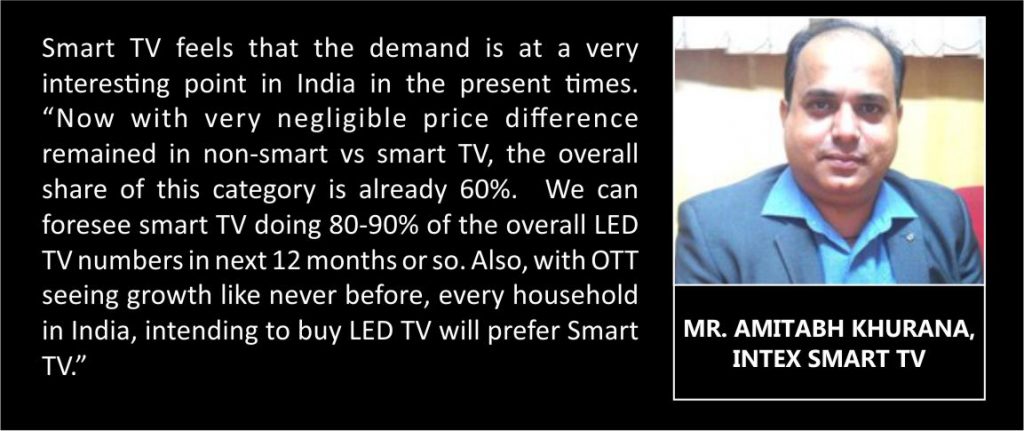
Mr Avneet Singh Marwah of Super Plastronics Pvt Ltd, “For the last 4 years, we have been really focusing on online sales, but we saw there is huge demand for premium affordable TVs in offline. We had received enormous number of inquiries from the offline channel. Therefore, we decided to partner with Qthree which has a strong presence in India. Currently, Kodak is available in more than 8000 counters and by end of 2021 it will be available in 150000 counters. Currently we are doing trade on all the top LFRs, and soon we will have presence in the local retail chains. We are offering a lot of new schemes like extent warranty, turnover discount and various finance options.”
Justin ZHONG of TCL, “Using our industrial capability, our vertical integration, and CSOT panel factory in India, we try to offer the best products to our channel and the end users.”
Mr Amitabh Khurana of Intex Smart TV, “We are striving to increase our penetration into the untapped markets and increase our billing counters. We are also bringing trade-friendly policies and keep our product pricing in such a way that it’s a win-win situation for the consumer and partners alike.”
The future plans of different Smart TV brands
Mr Pawan Kumar of Elista, “We plan to bring the best of innovations through our range of TVs. Our R&D teams are already working on our future plans and in the next 2 years, we see ourselves as one of the leading Smart TV brands in India.”
Mr Avneet Singh Marwah of Super Plastronics Pvt Ltd, “We are investing Rs 300 crore in the next three years to set up a fully automated TV manufacturing plant in Hapur, Uttar Pradesh. This will further strengthen our position as one of the leading manufacturers in the affordable smart TV segment. We are planning to produce one million TV sets annually and the new facility will be equipped with two fully automated, AI-enabled manufacturing lines to facilitate near-contactless production. In terms of other infrastructure, in the next two years we ought to have 1000 service centres with 70 warehouses across India. Our goal is to give installation and service under 24 hours in 15000 PIN code areas in the next 2 years. Kodak TV has a market share of 5% in India, we want to expand that to 8% in next two years.”
Justin ZHONG of TCL, “We want to bring more advanced technologies to the Indian customers for the Smart TVs to become Smarter TVs, not just some UI update. We will bring in more personalized smart functions, and functions that can really make the people’s viewing experience easier and smarter. We are targeting to be among the TOP 3 Smart TV brands in India.”
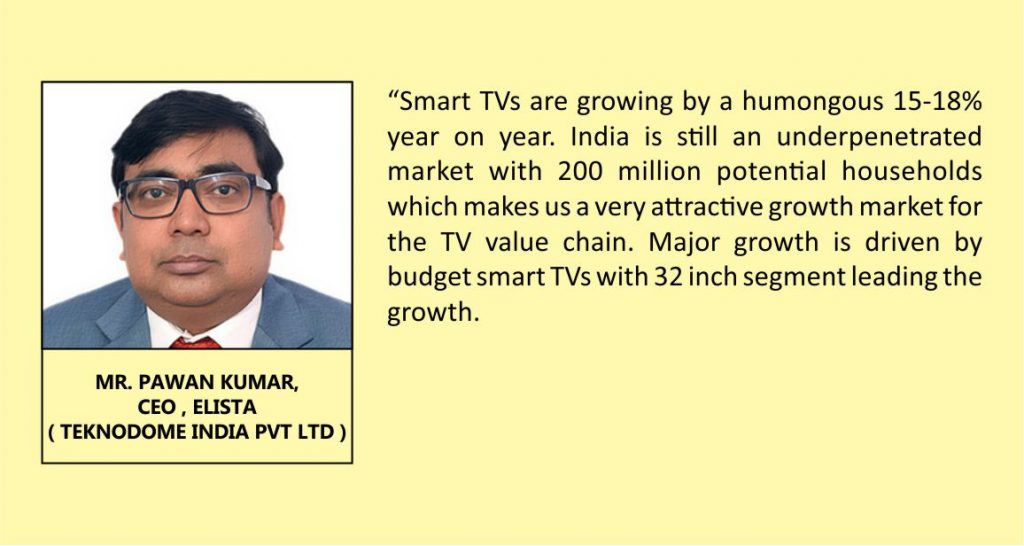
Mr Amitabh Khurana of Intex Smart TV, “As the market for Smart TV is now shifting to bigger screens, Intex is working day and night to make the best of technology in the segment available to the users at affordable prices. We have an exciting line-up already planned and we are looking forward to retain our numero uno position amongst the Indian brands.”
Mr Mandeep Arora of UBON says, “Talking about the future plans, we see a lot of opportunities for those brands which will use the right mix of technologies, features and design in the TVs. Our team at UBON labs is constantly working & researching the ways to provide the best-in-class experiences to our customers. We are planning to increase our production capacity in our unit. One major challenge that all the tech companies are facing in the country is the cost of imported LED components. However, on the lighter side, the demand for our LED TVs has been continuously on the rise.”
In a nutshell
Smart TVs are today evolving into integrated solutions for the users to enjoy from home, connect from home, and conference from home. We are going to see a lot of new innovations like voice- and AI-enabled features, local language-enabled services, the ability to connect more devices, and so on in the Smart TV segment. Companies are also continually improving their infrastructure, channel strategies, and channel training programs to help their channel partners to stay up-to-date, relevant, and become future-proof.





